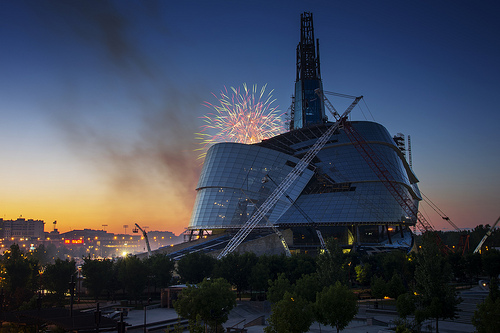Homelessness and human rights took centre stage at two of Winnipeg’s iconic locales this past weekend: at Portage and Main, the Downtown BIZ’s third annual CEO Sleep-out, and at the Forks, the inaugural opening of the Canadian Museum for Human Rights. With the Sleep-out, the BIZ was drawing attention to the issue of homelessness, as well as the poverty, addiction and mental illness that contribute to it. For the museum, a celebration of human rights. Both issues are important. Both are deserving of society’s attention and, even more so, action.
However, do a group of CEOs, politicians, glad-handers and hangers-on camping out at Portage and Main—comfortably, in sleeping bags—do much to actually alleviate homelessness? Does a national museum for human rights—built at a cost of nearly $400 million—do anything to address the continuing human rights violations of the very peoples on whose land the museum is situated?
Sure, supporters of both events would undoubtedly argue they’re “raising awareness” about these issues. Raising awareness: a bromide too frequently substituted for actually doing something. Is there a person in this city, or any for that matter, who isn’t aware there are some who are tragically homeless? Is there a person here, or anywhere in Canada, who isn’t aware of the myriad ways governments and churches together conspired to erase the existence of Aboriginal peoples—or the crippling poverty in which so many still live?
[related_content slugs=”17956″ description=”More from Kris Ade” position=”right”]
But think of the money the Sleep-out raised! Nearly $200,000! Yes, imagine if the roughly 160 participants had each simply written a cheque for $1,250, and hadn’t talked or tweeted about it. Or was that what was meant by “raising awareness?” Those selfless sleepers were raising awareness about their own selflessness.
Honestly, there’s nothing dignified about slum tourism. And what else to call a guided (and guarded) tour of downtown’s shelters and soup kitchens; a food truck serving ribs and oysters at midnight; be-gowned and be-jewelled VIPs, fresh from the museum’s gala, photo-bombing campers’ selfies? Raising awareness, indeed.
(Pro tip, campers: if you’re looking for ways to network, join LinkedIn or attend a Chamber of Commerce luncheon. Don’t spend the night beneath Winnipeg’s own JumboTron, warmed by its glow, the small-batch bourbon in your mongrammed flask, and that down-stuffed sleeping bag.)
Meanwhile, on the very same banks as the CMHR, individuals have had to take it upon themselves to dredge the Red River for the remains of Aboriginal women and girls—taken, tortured, then dumped like refuse to be forgotten—because there isn’t the will amongst wider society to give closure to their families and friends.
As has been well publicized, across Canada over 1000 Aboriginal women are either missing or, worse, presumed murdered; their lives snuffed out, their very existence erased by acts of utter inhumanity. Erased. Not unlike the genocide committed against Canada’s Aboriginal peoples; a genocide recognized by academics, historians, even the United Nations—but not by the very museum located on Treaty 1 land, designed and dedicated to the exploration of and education about human rights, a stone’s throw from where Tina Fontaine’s body was found stuffed in a plastic bag.
How can the “Tower of Hope” possibly inspire such feelings of optimism if, at the same time, the very institution on which it stands refuses to acknowledge the full scope of atrocities committed against Aboriginal peoples historically, or the crimes being committed against them right now on the museum’s own river bank?
Oh, but surely the generations of students from Winnipeg and across the country that will pass through the museum’s doors will be forever changed by the interactive, multi-media exhibits documenting the nasty things people have done to each other and the ways in which Canada and other countries have worked to ensure such atrocities aren’t repeated! Surely, too, ours will become a more tolerant, inclusive society because of this national museum, the first of its kind outside of the nation’s capital. And surely, above all, there was no better way to spend over a quarter of a billion dollars on the cause of human rights!
Why must it be an either-or proposition? Why can’t we have awareness-raising sleep-outs and actually help end homelessness; erect a museum for human rights and actually do something to stop their ongoing violations in this country? We can, but we rarely do. Too often governments, emboldened by an electorate overcome with cognitive dissonance, choose spectacle over substance; the shorter, less complicated, less uncomfortable route.
Fitting, then, the Downtown BIZ’s CEO Sleep-out and the opening gala of the Canadian Museum for Human Rights took place on the same night, both nothing more than spectacles fuelled by ego shockingly insenstive in their handling of the issues they’re meant to be addressing. And above all, considered substantive only through willful ignorance.
